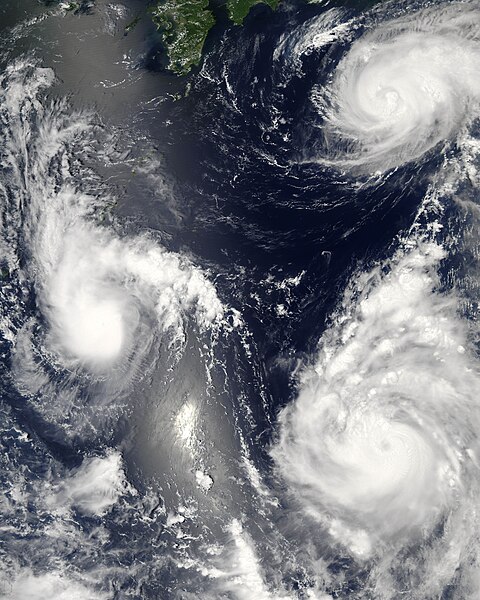Typhoon Morakot, known in the Philippines as Typhoon Kiko, was the deadliest typhoon to impact Taiwan in recorded history. The eighth named storm and fourth typhoon of the 2009 Pacific typhoon season, Morakot wrought catastrophic damage in Taiwan, killing 673 people and leaving 26 people missing, and causing roughly NT$110 billion (US$3.3 billion) in damages. Morakot originated as a tropical depression in the West Pacific on August 2. The system initially moved northeastward, before taking a westward track, developing into a tropical storm on August 3, with the JMA giving it the name Morakot. The storm gradually strengthened as it moved towards Taiwan, intensifying into a Category 1-equivalent typhoon on August 5. Morakot reached its peak intensity on August 7, with a minimum central pressure of 945 millibars (27.9 inHg), maximum 10-minute sustained winds of 140 km/h (85 mph), and maximum 1-minute sustained winds of 150 km/h (90 mph). Afterward, Morakot's forward motion slowed and the system gradually weakened, making landfall on central Taiwan later that day as a severe tropical storm. Over the next day, Morakot slowly meandered over Taiwan, before emerging into the Taiwan Strait and turning northward, making landfall on Mainland China on August 9. Afterward, Morakot accelerated northward while gradually weakening, before later turning northeastward. On August 11, Morakot degenerated into a remnant low in the East China Sea, before dissipating on August 13, over northern Japan.

Morakot approaching Taiwan on August 7
Tropical Storm Morakot over eastern China on August 9
Flooding in the Philippines
Provincial Highway 16 collapsed, causing seven cars to be washed into the Zhuoshui River.
A typhoon is a tropical cyclone that develops between 180° and 100°E in the Northern Hemisphere and which produces sustained hurricane-force winds of at least 119 km/h (74 mph). This region is referred to as the Northwestern Pacific Basin, accounting for almost one third of the world's tropical cyclones. The term hurricane refers to a tropical cyclone in the north central and northeast Pacific, and the north Atlantic. In all of the preceding regions, weaker tropical cyclones are called tropical storms. For organizational purposes, the northern Pacific Ocean is divided into three regions: the eastern, central, and western. The Regional Specialized Meteorological Center (RSMC) for tropical cyclone forecasts is in Japan, with other tropical cyclone warning centres for the northwest Pacific in Hawaii, the Philippines, and Hong Kong. Although the RSMC names each system, the main name list itself is coordinated among 18 countries that have territories threatened by typhoons each year.

Satellite image of Typhoon Mangkhut
Three different tropical cyclones active over the Western Pacific Ocean on August 7, 2006 (Maria, Bopha, and Saomai). The cyclones on the lower and upper right are typhoons.
Tracks of all tropical cyclones in the northernwestern Pacific Ocean between 1980 and 2005. The vertical line to the right is the International Date Line.







